The roof is the main protective element of the house, so a responsible approach is required for its construction. It also performs an aesthetic function. The polycarbonate roof is used in the construction of utility structures and residential buildings. However, you should choose the right roofing material. It is suitable for creating simple, complex, single and gable structures, any architectural projects.
Properties of polycarbonate
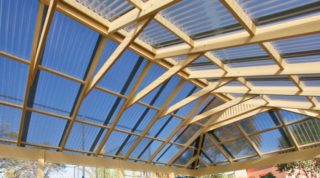
For the manufacture of polycarbonate, polymers are used. A special production technology provides an increased level of strength, resistance to temperature extremes. The material has a unique structure, since air chambers are located inside the slabs. Thanks to this, polycarbonate provides sound and thermal insulation.
Material properties:
- resistance to mineral oils, weak acid solutions, salts, but the material cannot be painted, treated with gasoline, solvents, varnish;
- environmental friendliness (the material does not harm the environment and human health);
- high degree of impact strength, hardness even at temperatures of -50 degrees;
- resistance to frost, corrosion processes;
- high level of vapor permeability;
- minimum temperature deformations (there is a possibility of attaching any fittings);
- good dielectric properties, impact strength;
- ease of processing;
- preservation of material properties in the temperature range from -100 to +135 degrees.
Without proper protection, the material is not resistant to direct sunlight.
Since the surface of the roof polycarbonate is smooth, it is easy to maintain.
Transparent sheets transmit up to 86% of light, and colored sheets - 20-30%. The latter option is used to cover shopping malls.
Varieties of polycarbonate for the roof
Before choosing a roof covering, you need to consider its varieties. Monolithic and cellular polycarbonate are distinguished.
Monolithic
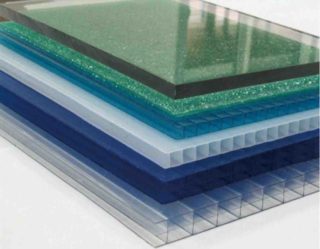
The monolithic version is made from polymer granules. It does not have voids, since the raw materials are first melted at a high temperature, and then dense sheets are formed using a press. A double layer of sun protection is applied to both surfaces of the products, increasing resistance to ultraviolet radiation. In this case, the light transmission does not deteriorate.
The material is durable, it is used for a long time. By weight, it is slightly heavier than a cell phone, but it does not exert a significant load on the foundation. The panels are used for roofs of any structure. The only drawback of roofing monolithic polycarbonate is the relatively high cost. However, installation does not require special equipment or a large number of tools.
The material consists of several reinforced layers, therefore it is resistant to mechanical damage and cracking. It can be highly heat-resistant, of increased hardness, fire resistance, and with an anti-reflective coating. Polycarbonate is hardly flammable, and in case of fire it extinguishes on its own. When dropped, the material is completely safe, since it does not break into fragments and does not form sharp corners.
Cellular
Cellular roofing polycarbonate is lightweight, easy to process, and provides good thermal insulation.It is made from a granular polymer by extrusion. Sheets are usually multilayer with stiffeners inside. They are perpendicular. In some profile panels there are additional partitions placed at an angle.
The disadvantage of the product is the risk of liquid entering the air cells. This material is not suitable for residential buildings. It is used to cover terraces, gazebos and other small objects.
Features of the polycarbonate roof
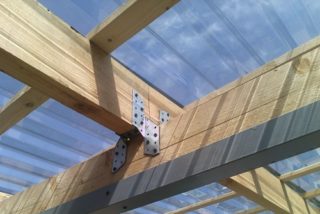
Polycarbonate roofing maintains performance at temperatures from -40 to +120 degrees. The service life of the material, if used correctly, is about 20 years. Polycarbonate sheets are produced in different shapes, sizes, colors. To mount the product on a non-standard structure, a crate is first formed, and then the material is attached to it.
The polycarbonate roof differs in that it transmits light rays, therefore it is often used in the construction of greenhouses, terraces, and open buildings. When installing sheets, you can achieve visual integrity of the structure, since the joints between the polymer elements are invisible. Another feature of the product is the ability to combine it with other materials.
For cutting polycarbonate for the roof, special electrical tools are used. It is better to take a tool with a disc, working at high speed.
All installation work is carried out without removing the protective film. A special tape is used to seal the sections. Due to the density and mechanical stability of the sheets, bolts with sealing rubber washers are used for their fastening. For laying on residential buildings, roofing profiled polycarbonate is used.
Necessary tools and materials for work
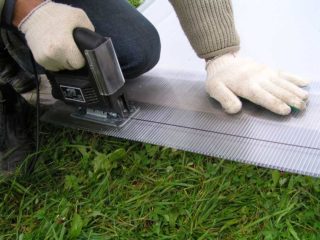
For laying wavy profile polycarbonate, as well as its other varieties, use the following tools:
- marker, building level for marking the base;
- ruler and tape measure;
- wooden hammer;
- drills, jigsaw or hacksaw with a thin blade and fine teeth;
- screwdriver and drill.
The calculation of the required amount of polycarbonate depends on the area of the base. You need to buy 10% more sheets than necessary. For work, you will also need a waterproofing layer, an adhesive-based sealant, thermal washers. Profiles are used to decorate the ends.
DIY polycarbonate roof installation technology
The choice of roofing material depends on the structure of the roof, its area, as well as the operating conditions. The cheapest canvases can last no more than 8 years, while premium products can last up to 20 years. To achieve the maximum level of insulation of the structure, it is better to buy material of increased thickness. For the construction of complex roofs, thinner canvases are required. Thick ones will not work, since they cannot be bent.
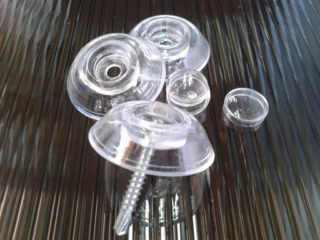
If you manage to choose a suitable material for the roof of a house made of polycarbonate, you can proceed with its installation. To do this on your own, drawings are pre-made, which indicate the locations of all sheets, fittings with exact dimensions. The design documentation indicates the dimensions of the structure and the shape of the future structure.
Installation involves the following stages:
- Arrangement of the rafter system. What matters is the correct angle of inclination of the base. The minimum indicator is 50 degrees. For the manufacture of supporting structures, beams are used with a section of 6 × 8 or 6 × 4 cm.The step between the rafter legs is 1 meter. The same distance is observed from the edge of the roof to the extreme support. To form a semicircular structure, connecting and end profiles are required.
- Material preparation. The side surfaces are glued with tape.
- Installation of sheets. The seams between the canvases should not be visible, so the joints are not treated with mastic.Self-tapping screws are screwed in every 30 cm. The sheets are cut so that the protective layer is not damaged.
Fasteners can be directly screwed into polycarbonate or pre-made holes for them. To do this, use drills for non-ferrous metal. When screwing the self-tapping screw, a gap of 1-2 mm is left between its head and the surface of the sheet. After laying the plates, you should not remove the protective film, but if it is constantly in the sun, they get rid of it.
The vertical orientation of the stiffeners is considered to be a peculiarity of the laying. After completion of the installation, check the accuracy of the installation and the integrity of the coating. All exterior finishing work must be completed prior to laying the sheets. To prevent overheating of the support structure, the polycarbonate surface can be painted white.
The material does not require any special care. It is enough to periodically clean it from dust and dirt with a simple soap solution.








